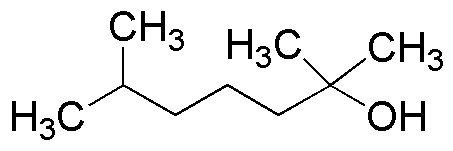2,6-Dimethyl-2-heptanol is widely utilized in research focused on:
- Solvent Applications: This compound serves as an effective solvent in various chemical reactions, particularly in organic synthesis, allowing for improved solubility of reactants.
- Flavor and Fragrance Industry: It is used in the formulation of flavors and fragrances, providing a pleasant scent profile that enhances consumer products like perfumes and food additives.
- Cosmetic Formulations: The compound is incorporated into cosmetic products for its emollient properties, helping to improve skin feel and moisture retention in lotions and creams.
- Chemical Intermediate: It acts as a precursor in the synthesis of other chemicals, facilitating the production of various compounds used in pharmaceuticals and agrochemicals.
- Research and Development: In academic and industrial labs, it is often used in studies related to alcohols and their derivatives, aiding in the exploration of new chemical reactions and applications.
General Information
Properties
Safety and Regulations
Applications
2,6-Dimethyl-2-heptanol is widely utilized in research focused on:
- Solvent Applications: This compound serves as an effective solvent in various chemical reactions, particularly in organic synthesis, allowing for improved solubility of reactants.
- Flavor and Fragrance Industry: It is used in the formulation of flavors and fragrances, providing a pleasant scent profile that enhances consumer products like perfumes and food additives.
- Cosmetic Formulations: The compound is incorporated into cosmetic products for its emollient properties, helping to improve skin feel and moisture retention in lotions and creams.
- Chemical Intermediate: It acts as a precursor in the synthesis of other chemicals, facilitating the production of various compounds used in pharmaceuticals and agrochemicals.
- Research and Development: In academic and industrial labs, it is often used in studies related to alcohols and their derivatives, aiding in the exploration of new chemical reactions and applications.
Documents
Safety Data Sheets (SDS)
The SDS provides comprehensive safety information on handling, storage, and disposal of the product.
Product Specification (PS)
The PS provides a comprehensive breakdown of the product’s properties, including chemical composition, physical state, purity, and storage requirements. It also details acceptable quality ranges and the product's intended applications.
Certificates of Analysis (COA)
Search for Certificates of Analysis (COA) by entering the products Lot Number. Lot and Batch Numbers can be found on a product’s label following the words ‘Lot’ or ‘Batch’.
*Catalog Number
*Lot Number
Certificates Of Origin (COO)
This COO confirms the country where the product was manufactured, and also details the materials and components used in it and whether it is derived from natural, synthetic, or other specific sources. This certificate may be required for customs, trade, and regulatory compliance.
*Catalog Number
*Lot Number
Safety Data Sheets (SDS)
The SDS provides comprehensive safety information on handling, storage, and disposal of the product.
DownloadProduct Specification (PS)
The PS provides a comprehensive breakdown of the product’s properties, including chemical composition, physical state, purity, and storage requirements. It also details acceptable quality ranges and the product's intended applications.
DownloadCertificates of Analysis (COA)
Search for Certificates of Analysis (COA) by entering the products Lot Number. Lot and Batch Numbers can be found on a product’s label following the words ‘Lot’ or ‘Batch’.
*Catalog Number
*Lot Number
Certificates Of Origin (COO)
This COO confirms the country where the product was manufactured, and also details the materials and components used in it and whether it is derived from natural, synthetic, or other specific sources. This certificate may be required for customs, trade, and regulatory compliance.

